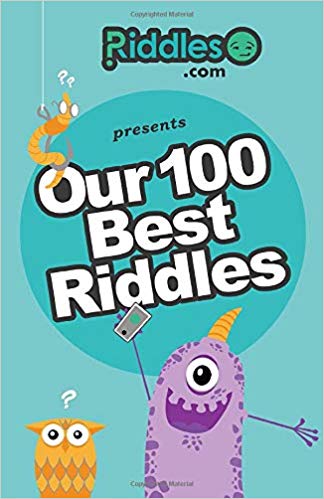Enter a keyword into the search box. The riddle search will check to see if the word is in the Title, Riddle, or Answer and return results if they exist.
"Computer" Riddles - Next 10 of 21.
Riddle:
Which way did the thief go when he stole the computer?
Answer: Data-way.
Riddle:
What is a computer virus?
Answer: A terminal illness.
Riddle:
Name a five letter word which has three consonants all the same and two different vowels. Every now and then you see this while running a Windows 95/98 on your PC. What is it?
Answer: Error!
Riddle:
Two ladies were detained by security officers at an airport–one of whom claimed to be a computer scientist, and one of whom claimed to be a geographer. One of them was secretly a smuggler! A security officer asked the supposed computer scientist, "Do you know about the Gava computer program?". The woman answered, "Do you mean Java?". The security officer then asked the supposed geographer, "Have you ever been to the capital of Spain, that is, Granada?". The geographer said, "Yes! It's a beautiful city!". Who was the smuggler?
Answer: The capital of Spain is Madrid, not Granada. If the second woman was really a geographer, she would know this; she must be the smuggler!
Riddle:
What gave birth to everything in a computer system?
Answer: The MOTHERboard.
Riddle:
Slam slam slam all day long slam slam slam some fast, some slow something solid. flat and sturdy its friend lights up the night and is sensitive to the eye slam slam slam A through Z 1,2,3 black as night. What am I?
Answer: A Computer keyboard.
Riddle:
Cat, horse, monkey; Hat, sombrero, cappello; Sheep, wool, haggis; Dairy, blueberry, cherry; Television, computer, phone; Which set of words doesn't belong?
Answer: Dairy, blueberry, cherry; All sets of words have a common theme, but this set of words is the only one that rhymes.
Riddle:
What do computer programmers sing in the shower?
Answer: Disc-o.
Riddle:
You and your friend are trapped in a space prison on an alien planet. The alien warden decides to give you and your friend a chance at freedom. He states that your friend shall be allowed to temporarily leave your cell and try to escape through an electric gate guarded by a 3-number passcode. If your friend answers incorrectly or says anything but the final answer, your friend will be thrown back in the prison. A computer will then tell your friend 4 clues if requested. If this passcode is properly answered, you and your friend shall be freed. You are then blindfolded and your friend leaves. You hear your friend walk down one of the numbered hallways to the gate. Your friend asks for the first clue. A voice answers, "The numbers are in ascending order so that the number is greater than or equal to the number before it." Your friend asks for the second clue. The voice says, "The product of the 3 numbers is 36." Your friend asks for the third clue. The voice says, "The sum of the numbers is the number of the hallway you entered." Your friend pauses for a moment and thinks. Your friend then asks for the fourth and final clue. The voice says, "The largest number only appears once in the code." You hear a beep. You hear your cell door swing open. You are free! What was the code?
Answer: 2,2,9
Riddle:
You're stranded in a rainforest, and you've eaten a poisonous mushroom. To save your life, you need an antidote excreted by a certain species of frog. Unfortunately, only the female frog produces the antidote. The male and female look identical, but the male frog has a distinctive croak. Derek Abbott shows how to use conditional probability to make sure you lick the right frog and get out alive. How do you get out alive?
Answer: If you chose to go to the clearing, you're right, but the hard part is correctly calculating your odds. There are two common incorrect ways of solving this problem. Wrong answer number one: Assuming there's a roughly equal number of males and females, the probability of any one frog being either sex is one in two, which is 0.5, or 50%. And since all frogs are independent of each other, the chance of any one of them being female should still be 50% each time you choose. This logic actually is correct for the tree stump, but not for the clearing. Wrong answer two: First, you saw two frogs in the clearing. Now you've learned that at least one of them is male, but what are the chances that both are? If the probability of each individual frog being male is 0.5, then multiplying the two together will give you 0.25, which is one in four, or 25%. So, you have a 75% chance of getting at least one female and receiving the antidote. So here's the right answer. Going for the clearing gives you a two in three chance of survival, or about 67%. If you're wondering how this could possibly be right, it's because of something called conditional probability. Let's see how it unfolds. When we first see the two frogs, there are several possible combinations of male and female. If we write out the full list, we have what mathematicians call the sample space, and as we can see, out of the four possible combinations, only one has two males. So why was the answer of 75% wrong? Because the croak gives us additional information. As soon as we know that one of the frogs is male, that tells us there can't be a pair of females, which means we can eliminate that possibility from the sample space, leaving us with three possible combinations. Of them, one still has two males, giving us our two in three, or 67% chance of getting a female. This is how conditional probability works. You start off with a large sample space that includes every possibility. But every additional piece of information allows you to eliminate possibilities, shrinking the sample space and increasing the probability of getting a particular combination. The point is that information affects probability. And conditional probability isn't just the stuff of abstract mathematical games. It pops up in the real world, as well. Computers and other devices use conditional probability to detect likely errors in the strings of 1's and 0's that all our data consists of. And in many of our own life decisions, we use information gained from past experience and our surroundings to narrow down our choices to the best options so that maybe next time, we can avoid eating that poisonous mushroom in the first place.

